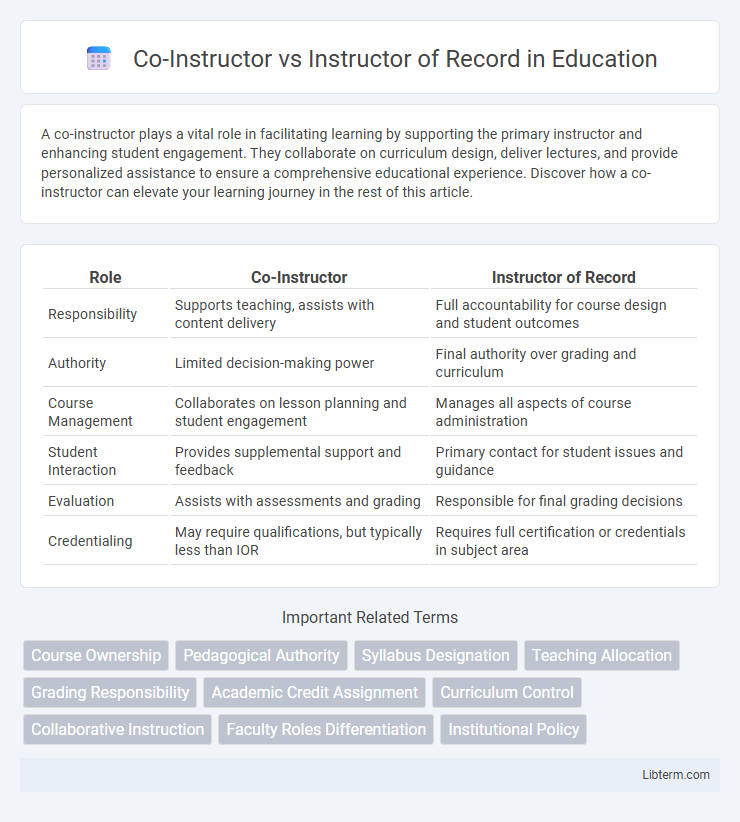A co-instructor plays a vital role in facilitating learning by supporting the primary instructor and enhancing student engagement. They collaborate on curriculum design, deliver lectures, and provide personalized assistance to ensure a comprehensive educational experience. Discover how a co-instructor can elevate your learning journey in the rest of this article.
Table of Comparison
| Role | Co-Instructor | Instructor of Record |
|---|---|---|
| Responsibility | Supports teaching, assists with content delivery | Full accountability for course design and student outcomes |
| Authority | Limited decision-making power | Final authority over grading and curriculum |
| Course Management | Collaborates on lesson planning and student engagement | Manages all aspects of course administration |
| Student Interaction | Provides supplemental support and feedback | Primary contact for student issues and guidance |
| Evaluation | Assists with assessments and grading | Responsible for final grading decisions |
| Credentialing | May require qualifications, but typically less than IOR | Requires full certification or credentials in subject area |
Understanding the Roles: Co-Instructor vs Instructor of Record
The Instructor of Record holds primary responsibility for the course, including grading, curriculum approval, and adherence to institutional policies, ensuring academic standards are met. The Co-Instructor collaborates in delivering course content and engaging students but typically does not have final authority over grades or official course decisions. Understanding these distinct roles clarifies accountability and contributes to effective course management within academic programs.
Key Responsibilities of an Instructor of Record
The Instructor of Record holds primary responsibility for developing course curriculum, delivering lectures, and assessing student performance to ensure academic standards are met. This role includes managing grades, maintaining attendance records, and serving as the official point of contact for students and academic administration. Unlike a co-instructor, the Instructor of Record has final authority over course content and evaluation criteria.
Duties and Expectations for a Co-Instructor
A Co-Instructor supports the Instructor of Record by sharing responsibilities such as developing course materials, delivering lectures, and assessing student performance. They collaborate closely to ensure curriculum alignment and maintain consistent communication with students, fostering a cohesive learning environment. Unlike the Instructor of Record, the Co-Instructor typically has less administrative authority but plays a crucial role in enhancing course delivery and student engagement.
Authority and Decision-Making: Who Leads the Course?
The Instructor of Record holds primary authority and is responsible for all major decision-making in the course, including grading, syllabus design, and compliance with institutional policies. A Co-Instructor supports instructional delivery and may lead specific sections or activities but does not have final authority over course decisions. This hierarchical structure ensures clarity in leadership, accountability, and adherence to academic standards.
Collaboration and Team-Teaching Dynamics
Co-Instructor roles emphasize collaborative course design, shared teaching responsibilities, and synchronous team-teaching to enhance student engagement and diverse perspectives. The Instructor of Record holds primary accountability for course outcomes, grading, and compliance with institutional policies, often coordinating with co-instructors to maintain consistency. Effective collaboration between Co-Instructor and Instructor of Record fosters dynamic pedagogical approaches, improves communication, and balances workload distribution.
Impact on Curriculum Design and Assessment
The Instructor of Record holds primary responsibility for curriculum design and assessment, ensuring alignment with accreditation standards and institutional learning outcomes; this role guarantees ownership over course content, grading criteria, and final evaluations. Co-Instructors contribute by collaborating on lesson planning and instructional strategies, yet they typically do not have authoritative control over the final assessment decisions or curriculum modifications. The delineation of roles impacts consistency, accountability, and the ability to implement curricular changes efficiently within academic programs.
Grading and Student Interaction Differences
The Instructor of Record holds primary responsibility for grading, ensuring consistency, accuracy, and adherence to academic policies, while a Co-Instructor may assist with grading but typically lacks final authority. Student interaction responsibilities for the Instructor of Record include leading discussions, addressing student concerns, and providing official feedback, whereas a Co-Instructor supports these activities by facilitating smaller group sessions or offering supplementary instruction. This division of roles ensures clear accountability in assessment and personalized student engagement.
Benefits and Challenges of Each Role
The Instructor of Record holds official responsibility for course content, grading, and compliance with academic policies, offering clear accountability and authority to ensure academic standards. Co-Instructors contribute specialized expertise and collaborative teaching, enhancing course depth and diversity, but may face challenges in delineating responsibilities and limited formal authority. Balancing the structured oversight of the Instructor of Record with the flexible, expertise-driven input of Co-Instructors optimizes educational outcomes yet requires clear communication and role definition to avoid conflicts.
Professional Development Opportunities
Co-Instructors often gain hands-on experience collaborating with seasoned Instructors of Record, enhancing teaching skills and curriculum design expertise. In contrast, Instructors of Record typically access leadership roles and faculty development programs tailored for course management and academic governance. Both roles contribute uniquely to professional growth, with Co-Instructors building foundational expertise and Instructors of Record advancing towards academic leadership positions.
Choosing the Right Role for Your Academic Career
Selecting between a Co-Instructor and Instructor of Record directly impacts your academic career trajectory and teaching responsibilities. The Instructor of Record holds full accountability for course development, student grading, and curriculum oversight, which enhances leadership credentials and faculty evaluation outcomes. Conversely, a Co-Instructor role offers collaborative teaching experience and mentorship opportunities but with shared responsibility, making it ideal for gaining instructional skills before advancing to a lead teaching position.
Co-Instructor Infographic

 libterm.com
libterm.com